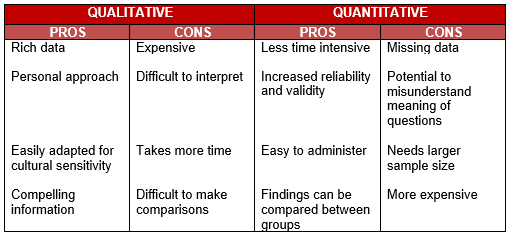You feel ready to collect data. You’ve figured out what question/s you need to answer and are prepared to go ahead and select a method to collect your data. Before taking this important step, let’s discuss qualitative and quantitative data. The previous post What is Quantitative and Qualitative Data? focused on the differences and similarities between each type of data. This blog post describes the pros and cons of using quantitative and qualitative data.
Pros and Cons
In research and evaluation, each type of data has pros and cons. Specifically, qualitative approaches provide rich data on topics that need to be better understood, are culturally sensitive, and may come from vulnerable populations. For example, a qualitative approach would likely be the best method if your organization serves undocumented workers. This approach helps give the people you serve a voice. However, analyzing qualitative data can be a bit tricky for some!
Quantitative methods are great for topics better established in the literature (e.g., youth resilience, job satisfaction). In fact, with quantitative data, there are typically several validated and reliable measures and tools that you can use. Quantitative methods also tend to be easier to implement and interpret. For instance, it is easier to measure how many people your organization serves than to describe the overall experiences of your clients. Below are some general pros and cons of both types of data.

Including Both Quantitative and Qualitative Data
You collect richer data when you include both quantitative and qualitative data. One common way to incorporate both data types is to have a survey that mostly asks quantitative questions. Still, at the conclusion, it includes a few open-ended questions where you allow the participant to make comments freely. Similarly, integrating some rating systems within a qualitative interview or focus group could help by bringing quantitative data into the research. When you understand the differences between qualitative and quantitative data, you can better determine what data collection method makes sense to answer whatever questions you need.
Additional Information
For additional information on qualitative and quantitative data, check out these resources:
http://regentsprep.org/regents/math/algebra/ad1/qualquant.htm
http://healthresearchfunding.org/pros-cons-quantitative-research/
http://occupytheory.org/advantages-and-disadvantages-of-qualitative-research/
Feel free to contact me with any research and evaluation needs at annette@researchevaluationconsulting.com


Thanks so much for sharing all with the awesome info! I am looking forward to checking out far more posts!